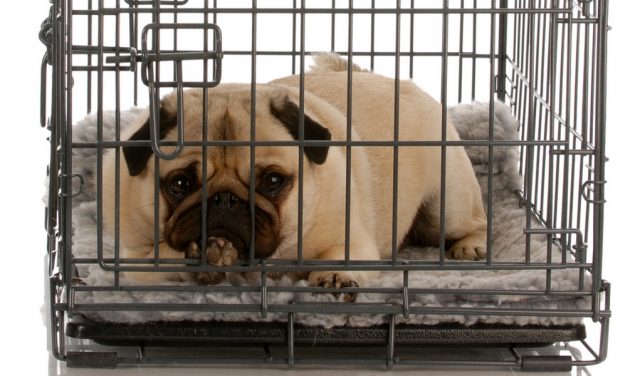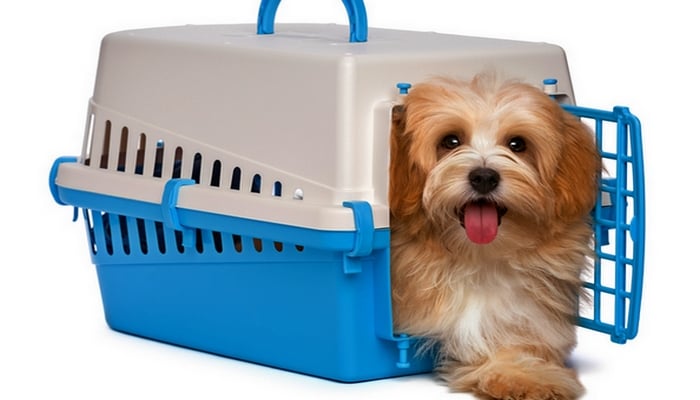
Table of Contents
Pet owners know that crate-training dogs are a great way to help our pets stay out of trouble when left alone, either when you leave for work or go to bed for the night.
However, many people don't know how to properly start the process of crate training a dog.
A dog crate and crate training itself are great tools for an owner.
There is a myth that crates represent something negative to dogs, but this has been debunked by many experts and dog trainers.
In fact, dogs enjoy their crates, and the result of crate training can be a happier, well-behaved canine, especially if starting with a puppy.
There are many different dog crates out there, and while they differ in construction, most of them represent the same thing to dogs.
So your choice of crate doesn't matter as much as the way you use it. As long as you avoid some of the below-mentioned mistakes of crate training dogs, your success is guaranteed.
The Association of Professional Dog Trainers (ADPT) has released an official statement regarding their stance on crate-training dogs, which reads:
“The Association of Professional Dog Trainers recommends the use of crates for puppies and dogs as a short-term training tool and as safety equipment throughout the dog’s life.” (source)
Not knowing where to begin and how to do this effectively can lead to frustration on your part, and your dog will feel bad, too.
If you want to start crate training a dog for his safety and comfort, you'll need to avoid some of these common mistakes listed below.
Pet owners who are new to dog training and have questions about how to properly crate train a canine should take a look at this video guide on crate training dogs.
Samantha discusses how to crate train a dog properly and mistakes that should be avoided.
MORE HELP: 10 Lessons on Effectively Crate Training Adult Dog
5 Mistakes of Crate Training a Dog
(And How to Fix Them)
Mistake #1. Hiding the Dog Crate
Many people don't like the look of their dog's crate, so they hide it away in an unused room. This is a huge mistake.
If you put the dog crate in a room where people don't spend any time, your dog may or may not want to use it.
The dog might feel isolated.
When crate training dogs, you should put the crate in the room where you spend the most time—like the living room.
This way, your pup will feel good about being in his crate since he will know you are still around. Believe it or not, the crate will quickly become his favorite hangout spot.
If you don't like the look of the crate, get creative! You can cover it with cardboard or planks of wood to create a little “end table” out of it.
Your dog will not mind; many dogs like having their crate dark and cool. Decorate it to match your other furniture, or look online for a “designer” crate. There are plenty of options to fit your personal style.
RECOMMENDED: 5 Types of Dog Crates and How to Choose A Perfect One
Mistake #2. Bare Minimum
Another mistake is not furnishing your dog's crate. Leaving it empty will be uncomfortable and unwelcoming for your pup.
To make it a nice little haven, put a comfortable dog bed inside or anything else that makes it feel more like home for the dog.
Consider your dog's preferences when picking one out. If he likes cozy pet beds, get something soft and fluffy. A bigger dog may prefer a cooler dog bed, a thin bed, or even just a blanket instead.
You can also put some toys or chews in your dog's crate for entertainment. Some good choices are soft dog toys that he might like to cuddle with and tough chews like KONG dog toys or Nylabones, which are the most popular choices among dog parents.
Make sure these are sturdy objects that can't be choked on if they get torn apart.
Putting these inside when crate training dogs will help keep your Fido occupied. It will also show him that his crate is safe with all his favorite things.
Mistake #3. Moving Too Fast
 Many people make the mistake of simply putting their dog in the crate, locking the door, and leaving for hours at a time. This will make your dog fear the crate, and it can cause some serious issues with crate-training dogs and housebreaking down the line.
Many people make the mistake of simply putting their dog in the crate, locking the door, and leaving for hours at a time. This will make your dog fear the crate, and it can cause some serious issues with crate-training dogs and housebreaking down the line.
For best results, you need to gradually introduce your dog to his crate when you first get it.
Start out by letting your pup explore his crate at his leisure. He'll likely sniff around and go in and out to check it out. Some dogs take to their crate right away—that's great if yours does!
If not, simply start rewarding the dog for going into the crate of his own volition; praise and treats are good choices. Eventually, your dog should start using his crate for rest.
Once he goes into his crate regularly, feed him inside to continue getting him used to it.
Rewards have been shown to be the most effective way to quickly train a dog, so why not?
After a few successful tries, start closing the door while Fido eats. Start by remaining in the area, but eventually, go to another room to see how your dog does in his crate alone.
Keep closing the door for increasing lengths of time, always monitoring your dog's anxiety level while in the crate. If he is doing okay for half an hour, you can start leaving him inside the crate for short periods of time.
Make sure he doesn't need to go potty before putting him in the crate. If your dog has an accident inside, it can set your crate training back quite a bit.
RECOMMENDED: 15 Best Small Dog Crates For Puppies or Small Dogs
Mistake #4. Punishment
 If you want your dog to see his crate as a safe place to be while you are gone, never use it as punishment. Crate training dogs should result in your pet being happy to go into his little oasis; using the crate as punishment will cause him to fear it, and he may stop going into his crate willingly.
If you want your dog to see his crate as a safe place to be while you are gone, never use it as punishment. Crate training dogs should result in your pet being happy to go into his little oasis; using the crate as punishment will cause him to fear it, and he may stop going into his crate willingly.
Remember, dogs respond better to positive reinforcement anyway. Praise, treats, and playtime are all better ways to teach your pooch appropriate behavior.
The only time your crate could be used as something akin to punishment is if your dog is overly excited or nipping.
If he needs to calm down, commanding him to go into his crate can give him a chance to relax. However, if you use this method, he should still be rewarded for following the command to go into his crate.
RELATED: 5 Best Dog Anxiety Vests to Relieve Stress in Dogs
Mistake #5. Confusing Signals
When crate training dogs, decide on one word to be used as a command for going into the crate, such as “crate” or “kennel.”
Stick with this one word when teaching him. If you use other commands, you will confuse your dog and cause him frustration. This can lead to issues with crate training, and he may not want to obey you.
Remember that hand signals are important, too. Many dogs respond to hand signals more than verbal commands.
To command your dog to go into his crate, try pointing at the crate. Watch this video guide on how to train a dog in basic commands for tips.
Get him used to this signal, and don't use that particular hand motion for any other commands. This will ensure your command is clear to your pup, and he'll understand what you want from him.
Crate training dogs can be very successful when done properly. A little research done before you start can really help you prepare.
If you're trying to crate train a new puppy or adult dog, avoid making these mistakes, and you should find that getting your pup used to his crate is a breeze!
RANKINGS: Top 50 Best Dog Crates of All Time














